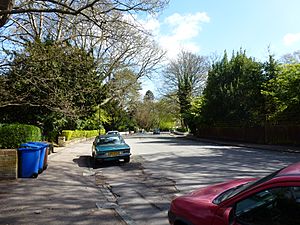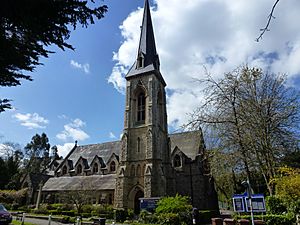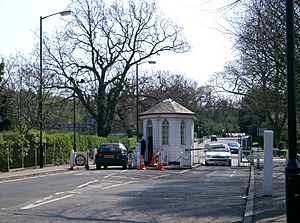Sydenham Hill facts for kids
Quick facts for kids Sydenham Hill |
|
|---|---|
 Crescent Wood Road |
|
| London borough | |
| Ceremonial county | Greater London |
| Region | |
| Country | England |
| Sovereign state | United Kingdom |
| Post town | LONDON |
| Postcode district | SE21, SE26, SE23 |
| Dialling code | 020 |
| Police | Metropolitan |
| Fire | London |
| Ambulance | London |
| EU Parliament | London |
| UK Parliament |
|
| London Assembly |
|
| Website | http://sydenham.org.uk/ |
Sydenham Hill is a lovely area in southeast London. It sits on a long ridge, which is like a natural hill. This area is known for being a nice place to live. Sydenham Hill is also the name of a road that runs along this ridge. This road helps mark the borders of three London boroughs: Southwark, Bromley, and Lewisham.
The very top of Sydenham Hill is one of the highest points in London! It reaches about 112 meters (367 feet) high. The road connects different parts of London. It links Forest Hill in the northeast to Crystal Palace in the southwest. You can find Sydenham Hill railway station, a nature reserve called Sydenham Hill Wood, and a golf course on its western side. Parts of the hill also stretch into the boroughs of Lambeth and Croydon.
Contents
Exploring Sydenham Hill's Geography
Sydenham Hill is about 9 kilometers (5.6 miles) southeast of Charing Cross. It is also close to many big shopping areas in south London. For example, it is 5.8 kilometers (3.6 miles) south of Lewisham. It is also 7.4 kilometers (4.6 miles) northwest of Bromley. Croydon is about 6.4 kilometers (4 miles) south.
Sydenham Hill is part of the large Norwood Ridge. This ridge is made of special clay deposits. Because of this, Sydenham Hill is one of London's highest spots. It stands at 112 meters (367 feet) tall. Sydenham Hill Wood is a nine-hectare nature reserve. It is located west of Sydenham Hill Road. There is also the Dulwich and Sydenham Hill Golf course nearby. Long ago, this hill was covered by a huge forest. It was called the Great North Wood. This forest covered all of Sydenham, Norwood, and other nearby areas.
A Look Back in Time
Sydenham Hill is the highest part of the eastern ridge of the Norwood Ridge. For thousands of years, this area was covered by the Great North Wood. In the 1800s, Sydenham Hill became a very popular place. Many large homes were built along Sydenham Hill Road. Some of these grand houses include Grange Court (1861) and Beltwood House (1851).
A big change happened in 1854. The famous Crystal Palace was moved from Hyde Park. It was rebuilt on the southwestern end of the ridge. This made the area even more important.
The Railway Arrives
In 1863, the Chatham Main Line railway opened. This brought trains to Sydenham Hill. To build the railway, workers had to dig a long tunnel. It was 1.9 kilometers (1.2 miles) long. The tunnel started at College Road and went under Sydenham. It ended near Penge.
Later, in 1884, another railway line opened. This new line was built to serve the Crystal Palace. It had a new station called Upper Sydenham. This station was on the southern edge of the ridge. Trains from here went directly to London Victoria. However, not many people used this line. When the Crystal Palace was destroyed, even fewer people used it. The railway line finally closed in 1954. This left an abandoned tunnel hidden within the Sydenham Hill Woods.
Living in Sydenham Hill
The area west and north of Sydenham Hill road is often called Dulwich. This mostly matches the SE21 postal code. The east side of the woods is known as Sydenham, or Upper Sydenham. This area uses the SE26 postal code. Sydenham Hill road and the ridge line mark the southern and eastern edge of the Dulwich Estate.
This area is almost entirely residential. It has many large homes built in the 1800s. College Road is a private road. It has a toll booth towards Hunts Slip Road. This toll has been there since the 1780s. On the other side of the railway, you can find the Kingswood Housing Estate. This estate includes Dulwich Wood Primary and Kingsdale Foundation Schools. It also has the Kingswood House Community Centre.
Other roads on the hill include Crescent Wood Road, Woodhall Drive, and Hitherwood Drive.
Getting Around Sydenham Hill
Bus Services
Several Transport for London bus routes run along Sydenham Hill road. These include routes 202, 356, 363, and N63. Routes 450 and 931 (on Fridays only) serve Fountain Drive and the Kingswood Estate.
Railway Travel
Sydenham Hill railway station is located on the private College Road. It also has another entrance in the Kingswood Estate. The station is served by Southeastern trains. These trains go to London Victoria, Herne Hill, Beckenham Junction, Bromley South, and Orpington. Trains run every 15 minutes from Monday to Saturday. On Sundays, they run every 30 minutes.
Thameslink also runs weekday peak-time services. These trains go to St Pancras International and Bedford. Sydenham Hill is one of the few stations in London without a dedicated bus stop. The closest bus stop is on Kingswood Drive, about 0.3 miles away.





